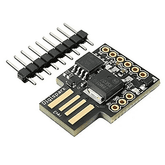What are Chatbots
What are Chatbots?
A chatbot is a software-based bot that can imitate human-like communication with users via websites and mobile applications. Chatbots answer user's queries and facilitate them to handle easy tasks without the assistance of a human. Chatbots are small programs that facilitate simulated interactions with customers automatically based on predefined conditions, triggers, and events.
How Do Chatbots Work?
At the middle of chatbot technology lies natural language processing (NLP), the same technology that forms the premise of the voice recognition systems employed by virtual assistants like Google Now, Apple's Siri, and Microsoft's Cortana.
Chatbots process the text given to them by the user. This method is called parsing. Before responding to a complex series of algorithms that interprets and identifies what the user said, deduce what they mean and wish, and confirm a series of appropriate responses based on the data.
Explore M5Stack Collection
Some chatbots offer a remarkably authentic colloquial expertise, during which it's difficult to infer whether the agent is a bot or a human being. Other bots are a lot easier to identify (much like the T-600 series of murderous robots in the popular Terminator sci-fi action movies).
Although chatbot technology is different from natural language processing technology, the former can advance as quickly as the latter; without continuing developments in natural language processing, chatbots stay at the mercy of algorithms' current ability to sight the delicate nuances in each written and spoken dialogue.
This is the place where most applications of natural language processing struggle, and not simply chatbots. Any system or application that depends upon a machine's ability to parse human speech is probably going to struggle with the complexities inherent in parts of speech like metaphors and similes. Despite these considerable limitations, chatbots are becoming more and more sophisticated, responsive, and more human-like.
Put differently, they are becoming more human.
Now we've established what chatbots are and the way they work, let us see some examples. Here are ten companies that are using chatbots for promoting, marketing, producing higher client service, sealing deals, and more. Companies like Google, Lyft, Fandango, Spotify, Whole Foods, Sephora, Mastercard, Staples, The Wall Street Journal, and Pizza Hut make efficient use of Chatbots.
ADVANTAGES OF CHATBOTS
1. They can be proactive or reactive.
2. Their responses are consistent each time.
3. They can reply to customers straight away.
4. They can assist you to collect vital knowledge and conjointly learn from the data collected.
5. They can be used through a range of various mediums like SMS, live chat, or even social media.
DIFFERENT ASPECTS OF CHATBOTS:
1. Conversational channel: A channel is a place where a chatbot is launched and where users will interact with it. It can be a website, Live chat, Facebook Messenger, WhatsApp, Slack, Kik, etc.
2. Artificial Intelligence: it's the area of computer science that is sometimes described as machine intelligence. It permits chatbots to perform tasks that might need human intelligence like decision making, language translation, or speech recognition.
3. NLP: Natural language processing is a branch of AI that helps computers read, understand, and make sense of the human language. It lets chatbots perceive the context and meaning of a user's message and react to that properly, even though the user makes a spelling or grammar mistake. Apart from chatbots, natural language processing powers lots of apps and services like Google Translate or Grammarly.
While these chatbots appear advanced, they're comparatively easy to build using chatbot tools like Mobile Monkey – founder Larry Kim's new Facebook Messenger marketing start-up. Mobile Monkey provides dozens of chatbot templates for various industries, functions as a WordPress chatbot, and supports integration with Facebook Messenger advertisements.
Explore Arduino Collection
This blog has been submitted by Cyborg, NIT Rourkela under the Robocraze Club Outreach Program.
Author: Aparajita Panigrahi






